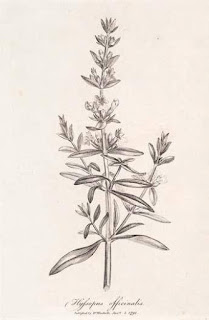Sneaky Herbs

Sneaky Herbs
In the spring following our move to Orchard St., I began to search the property for old plantings. There next to the back door presented a huge clump of chives. He looked so happy there I decided this was to be a kitchen/herb garden. Toby and I began cleaning the back yard and found huge slabs of slate buried under a few inches of grass and began outlining the perimeter of the garden with them.
This garden, three summers later, has many healing herbs in her soil: Chocolate Mint, Hyssop, Lavender, Calendula, Chamomile, Oregano, Thyme, Strawberry, Basil, Sage and a patio peach tree as a center piece. I have noticed that herbs that I didn’t plant have started to find their way into the garden as well. Violet, Mullen, and Burdock have moved in as well as the ever plentiful Dandelion and Plantain.
Although I have studied the medicinal properties of herbs for about nine years now I am such a beginner and I love that. I feel like a child whenever a plant reveals itself to me and I love that my learning is never done. I would like to share some of what I have gathered with you…
Hyssop
This info is taken from a really great source I highly recommend-
http://www.botanical.com:
Parts typically used: Aboveground parts of hyssop are collected during flowering. The essential hyssop oil is obtained with steam distillation.
Medicinal properties: Hyssop and its oil are mainly used to treat respiratory problems. The Greek Hippocrates already recommended hyssop to treat bronchitis. Today, hyssop is used for the treatment nasal congestion and mild irritations of the respiratory tract. The marrubiin of Hyssop facilitates the expectoration of mucus.
The hyssop essential oil has stimulant and antiseptic affects. The essential oil contain pinocamphone and isopinocamphone which have neurotoxic effects. The essential should therefore only be taken with care and in much diluted form.
Other facts:Hyssop originates from southern and south-eastern Europe. Hyssop cultivars are often used as plants in gardens. Hyssop oil is used as ingredient in some French liqueurs. Hyssop can also be used in the kitchen. The hyssop flowers and leaves can be used to flavour dishes, including soups, salads, sauces, meat dishes, vegetable dishes and fruit salads.Fresh and dried hyssop flowers are also used as decoration.
RECIPE FOR HYSSOP TEA
'Infuse a quarter of an ounce of dried hyssop flowers in a pint of boiling water for ten minutes; sweeten with honey, and take a wineglassful three times a day, for debility of the chest. It is also considered a powerful vermifuge.' (Old Cookery Book.)


Comments
Post a Comment